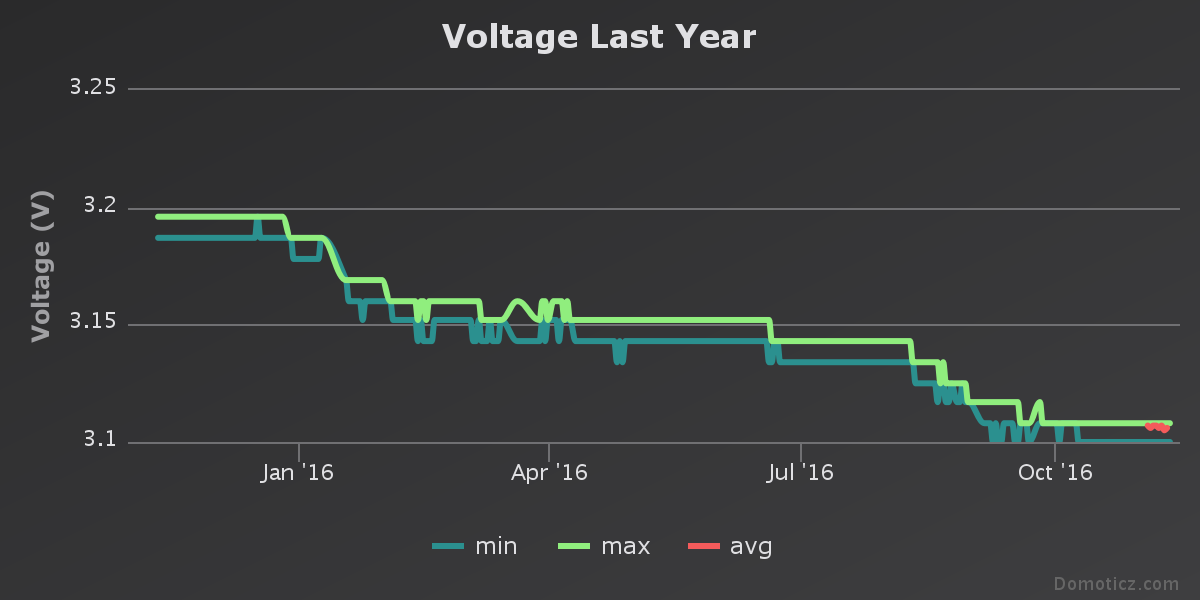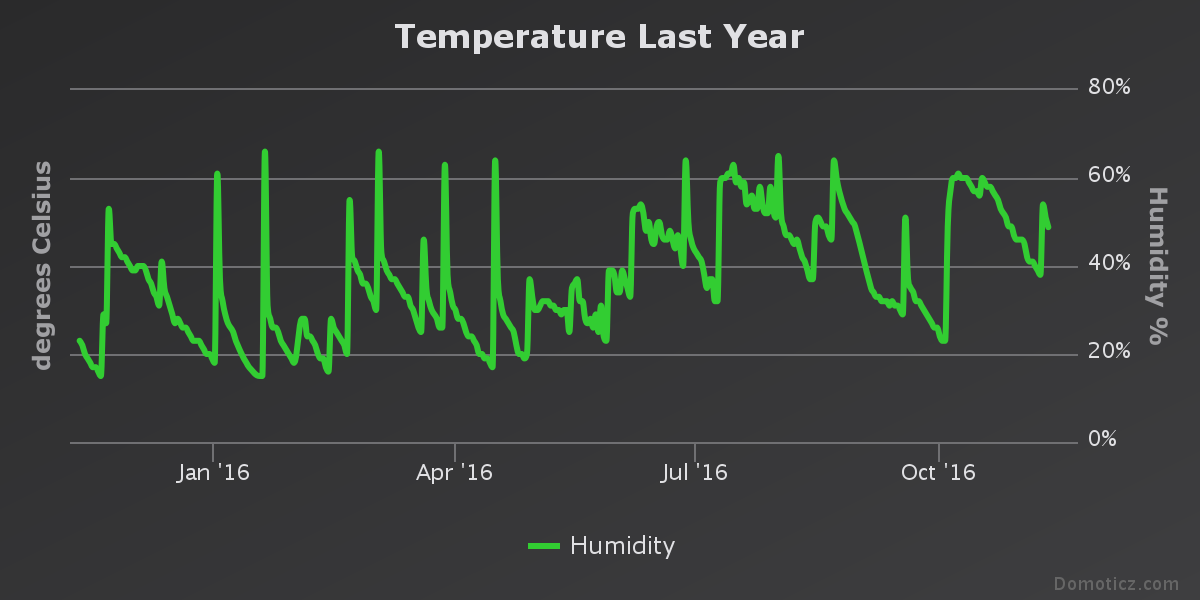Office plant monitoring
-
Its driving me crazy! Could you not convert this mfalkvidd! Its better to have your sketch on the front instead of that one there is there now.
-
After my other failed attempt I needed to try this.
I have a 5V Mini using A4 and A5 and a fork YL-69 and I get these result:Direction: 1
Moist: 171
Direction: 0
Moist: 23
Direction: 1
Moist: 172
Direction: 0
Moist: 0
Direction: 1
Moist: 164
Direction: 0
Moist: 0
Direction: 1
Moist: 156
Direction: 0
Moist: 0
Direction: 1
Moist: 144
Direction: 0
Moist: 0This is not the percentage value , its this value I print: moistureLevel = (1023 - analogRead(SENSOR_ANALOG_PINS[direction]));
Any Ideas?
-
After my other failed attempt I needed to try this.
I have a 5V Mini using A4 and A5 and a fork YL-69 and I get these result:Direction: 1
Moist: 171
Direction: 0
Moist: 23
Direction: 1
Moist: 172
Direction: 0
Moist: 0
Direction: 1
Moist: 164
Direction: 0
Moist: 0
Direction: 1
Moist: 156
Direction: 0
Moist: 0
Direction: 1
Moist: 144
Direction: 0
Moist: 0This is not the percentage value , its this value I print: moistureLevel = (1023 - analogRead(SENSOR_ANALOG_PINS[direction]));
Any Ideas?
@Martin-Tellblom could you describe what an YL-69 is?
How much time do you let the measurement settle after switching directions?
Which of the code versions are you using? There have been many revisions in this thread and they all work slightly different. -
@Martin-Tellblom could you describe what an YL-69 is?
How much time do you let the measurement settle after switching directions?
Which of the code versions are you using? There have been many revisions in this thread and they all work slightly different.@mfalkvidd said:
me do you le
My "Fork" is stamped with YL-69. Looks exacly like the XD-28
It's your code from post 25 so I suppose 1000 (#define STABILIZATION_TIME 1000 ) -
@mfalkvidd said:
me do you le
My "Fork" is stamped with YL-69. Looks exacly like the XD-28
It's your code from post 25 so I suppose 1000 (#define STABILIZATION_TIME 1000 ) -
@Martin-Tellblom Thanks. You did throw away the middle chip and only use the fork, right? (as described in post 41)
@mfalkvidd : Yes I did, and I have tried using A2&A3 and its the same
-
@mfalkvidd : Yes I did, and I have tried using A2&A3 and its the same
-
@mfalkvidd
Have tried both a 3.3V and a 5V both behave the same.
I check every 30 seconds now and after about 10 minutes the result is 0 on both directions.
I restart the arduino and then one direction shows a value and the other 0.
There is proberbly something with my forks :)Did I mention that I upgraded the sketch to 2.0? Could that be a problem?
-
@mfalkvidd
Have tried both a 3.3V and a 5V both behave the same.
I check every 30 seconds now and after about 10 minutes the result is 0 on both directions.
I restart the arduino and then one direction shows a value and the other 0.
There is proberbly something with my forks :)Did I mention that I upgraded the sketch to 2.0? Could that be a problem?
There is proberbly something with my forks :)
They are (or at least should be) completely passive, so there is nothing that should be able to go wrong.
Could you post a photo of your connections?
If you disconnect the fork from the Arduino and measure the resistance between the two connectors using a multimeter (in both directions), what resistance do you get?
Did I mention that I upgraded the sketch to 2.0? Could that be a problem?
Not if you did it right :) I have no experience with 2.0 unfortunately.
-
There is proberbly something with my forks :)
They are (or at least should be) completely passive, so there is nothing that should be able to go wrong.
Could you post a photo of your connections?
If you disconnect the fork from the Arduino and measure the resistance between the two connectors using a multimeter (in both directions), what resistance do you get?
Did I mention that I upgraded the sketch to 2.0? Could that be a problem?
Not if you did it right :) I have no experience with 2.0 unfortunately.
I at the office right now, measure them when I home
-
There is proberbly something with my forks :)
They are (or at least should be) completely passive, so there is nothing that should be able to go wrong.
Could you post a photo of your connections?
If you disconnect the fork from the Arduino and measure the resistance between the two connectors using a multimeter (in both directions), what resistance do you get?
Did I mention that I upgraded the sketch to 2.0? Could that be a problem?
Not if you did it right :) I have no experience with 2.0 unfortunately.
@mfalkvidd said:
should be) completely passive, so there is nothing that should be able to go wrong.
Could you post a photo of your connections?
Here is my setup. Using the Easy/Newbie board that @sundberg84 created with a 5V arduino mini pro 16Mhz. Using A4 and A5 to the sensor

Regarding the resistance when its out of the soil there is no connection at all. If I put it in the soil there a strange thing happening .
The resistance start around 10K and then slowly increase (no matter if I switch the direction) the longer I test the higher value.
If I switch the direction the resistance start from whre it just was and keep rising . If I let the senor pause for a while (5 minutes or so) it's back to around 10K.Maybe I test it to often? Don't let the moisture get back to the soil?
-
It seems like @sundberg84 nailed it :)
The battey metering I use with his PCB is this:#if defined(__AVR_ATmega2560__) analogReference(INTERNAL1V1); #else analogReference(INTERNAL); #endifAnd that reflect on all analog channels and break the function..
After I removed the battery sensing code it work great -
So my Bonsai tree humidity node just celebrated 1 year on battery! :tada: :gift_heart:
During the last year, the gateway has received 76,164 updates on humidity level (and an additional 13,996 updates on voltage level).The battery level has gone from 3.187V to 3.108V, which means an average drop of 0.0066V per month. Assuming I let it go down to 2.34V (limit for 8MHz according to the datasheet) and that the voltage drop is linear, I should get (3.187-2.34)/0.0066 = 128 months = ~10.7 years. There are several error sources in this calculation, but it looks like battery life will be quite good.
Here are the voltage and humidity graphs for the last year


